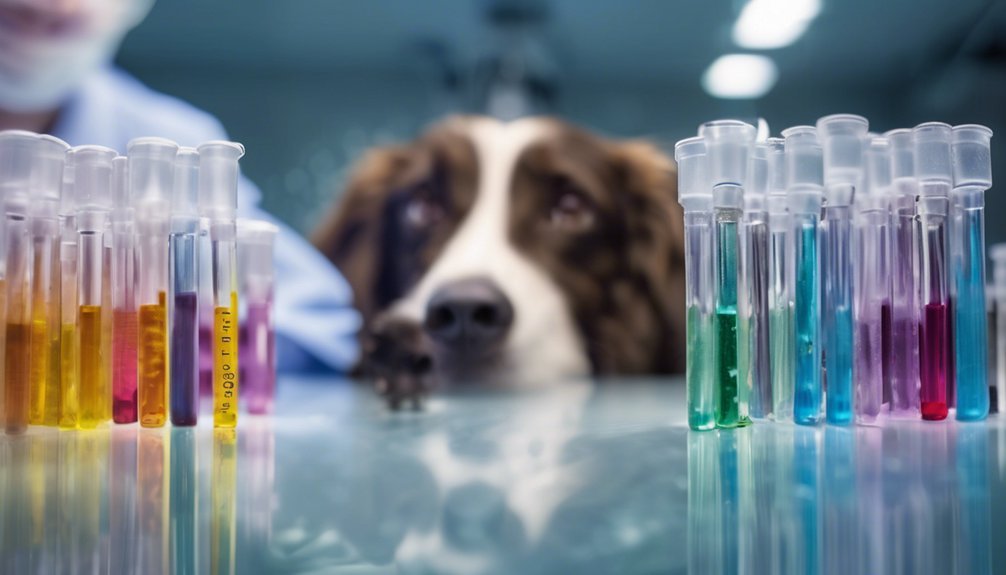You might be aware that fenbendazole, a common anthelmintic, faces significant bioavailability challenges due to its low solubility and extensive first-pass metabolism. This creates barriers to effective treatment in both veterinary and human applications. However, recent advancements in nano-formulations present a potential solution. These innovative delivery systems promise to enhance drug solubility and stability. But how do they achieve this, and what implications could these developments have for therapeutic practices?
Key Takeaways
- Nano-formulations, such as lipid nanoparticles and polymeric micelles, enhance the solubility and stability of fenbendazole for improved bioavailability.
- Cyclodextrin complexes increase fenbendazole solubility by forming inclusion complexes, facilitating better absorption in the body.
- Solid lipid nanoparticles and nanoemulsions provide controlled release, improving therapeutic efficacy and reducing side effects of fenbendazole.
- Dendritic polymers and metal nanoparticles offer innovative delivery methods, potentially enhancing drug encapsulation and stability.
- Advanced characterization techniques and research collaborations are essential for optimizing nano-formulations to improve fenbendazole’s bioavailability and therapeutic outcomes.
Understanding Fenbendazole and Its Mechanism of Action

Although you may be familiar with fenbendazole as an anthelmintic drug primarily used in veterinary medicine, its mechanism of action reveals a complex interplay with cellular processes.
Fenbendazole pharmacology involves selective inhibition of microtubule polymerization, disrupting cellular transport and function in parasites. This mechanism exploration highlights its effectiveness against various nematodes and protozoa. By binding to β-tubulin, fenbendazole interferes with the spindle apparatus during cell division, ultimately leading to cell death.
Additionally, fenbendazole’s impact on energy metabolism further contributes to its antiparasitic activity. Understanding these intricate mechanisms can enhance your ability to serve those in need, ensuring better therapeutic outcomes in both veterinary and potential human applications.
Thus, appreciating fenbendazole’s pharmacodynamics is vital in optimizing its use.
The Challenge of Poor Bioavailability
When considering the therapeutic potential of fenbendazole, the challenge of poor bioavailability becomes evident. This low bioavailability stems from several formulation challenges, primarily due to its hydrophobic nature.
These absorption barriers restrict fenbendazole’s solubility and, consequently, its effectiveness. When you administer fenbendazole, it often undergoes extensive first-pass metabolism, further diminishing its therapeutic concentration.
Absorption barriers limit fenbendazole’s solubility and effectiveness, with extensive first-pass metabolism reducing its therapeutic concentration.
This scenario underscores the need for innovative approaches to enhance absorption and bioavailability. By addressing these challenges, you can significantly improve fenbendazole’s clinical efficacy, allowing it to serve patients better.
Understanding these obstacles is vital for developing strategies that ensure optimal drug delivery, maximizing fenbendazole’s potential in therapeutic applications.
The Role of Nano-formulations in Drug Delivery
Nano-formulations offer a promising solution to the challenges posed by poor bioavailability in drug delivery systems, particularly for hydrophobic compounds like fenbendazole.
By utilizing nano delivery systems, you can enhance solubility and stability, allowing for more effective absorption in the body. These targeted formulations ensure that the drug reaches its intended site of action, reducing side effects and increasing therapeutic efficacy.
With their ability to encapsulate active ingredients at the nanoscale, they facilitate controlled release, improving patient compliance.
Furthermore, these formulations can be tailored to specific delivery routes, maximizing the potential of fenbendazole in clinical applications.
Ultimately, embracing nano-formulations can lead to significant advancements in drug delivery, benefiting patients and healthcare providers alike.
Types of Nano-formulations for Fenbendazole

Various types of nano-formulations for fenbendazole have emerged, each designed to optimize its delivery and efficacy. These innovative formulations enhance solubility and bioavailability, ensuring better therapeutic outcomes.
Here are three notable types:
- Lipid nanoparticles – They encapsulate fenbendazole, improving its stability and release profile.
- Polymeric micelles – These structures facilitate the solubilization of fenbendazole in aqueous environments.
- Cyclodextrin complexes – They form inclusion complexes that enhance the drug’s solubility.
In addition, other formulations like solid lipid nanoparticles, nanoemulsions, dendritic polymers, nanosuspensions, and metal nanoparticles offer various advantages in drug delivery.
Enhancing Absorption Through Nanotechnology
As researchers explore advanced drug delivery systems, enhancing the absorption of fenbendazole through nanotechnology has become a focal point.
Utilizing nano emulsions benefits significantly improve the solubility and bioavailability of this medication. By leveraging particle size optimization, these formulations create smaller droplets, increasing the surface area for absorption. This leads to a more efficient uptake in the gastrointestinal tract, ensuring that a greater proportion of fenbendazole enters systemic circulation.
Utilizing nano emulsions significantly enhances fenbendazole’s solubility and bioavailability, optimizing absorption for improved therapeutic outcomes.
Moreover, the stability provided by nano emulsions protects the active ingredient from degradation. By focusing on these innovative approaches, you’re not only improving therapeutic outcomes but also contributing to more effective treatment strategies for patients in need.
Embracing these advancements can ultimately enhance patient care and efficacy in drug administration.
Comparative Studies on Bioavailability Improvements
Recent studies have highlighted significant improvements in bioavailability when comparing traditional fenbendazole formulations to innovative nano-based alternatives.
These bioavailability comparisons reveal notable enhancements in formulation efficiency through various mechanisms:
- Increased Surface Area: Nano-formulations present a larger surface area, facilitating faster absorption.
- Enhanced Solubility: The smaller particle size improves solubility, leading to better drug dissolution in gastrointestinal fluids.
- Targeted Delivery: Nano-carriers can enhance targeted delivery, ensuring that more active compounds reach systemic circulation.
These findings underscore the potential of nano-technology to significantly improve fenbendazole’s effectiveness.
Implications for Veterinary Medicine

The advancements in nano-formulations of fenbendazole hold significant promise for veterinary medicine, particularly in enhancing the treatment efficacy of parasitic infections in animals.
By improving drug bioavailability, these formulations can ensure that lower doses achieve effective results, minimizing the risk of adverse reactions.
You’ll find that veterinary applications of nano-fenbendazole could revolutionize standard protocols, enabling more targeted treatments for various species.
This enhanced drug efficacy not only serves to effectively manage infections but also contributes to better animal welfare and reduced treatment costs.
Furthermore, utilizing nano-formulations could lead to decreased environmental impact by lowering the overall dosage required.
Embracing these innovations fosters a proactive approach in veterinary practice, ultimately benefiting both practitioners and animal patients alike.
Potential Applications in Human Medicine
While exploring the potential applications of nano-formulations of fenbendazole in human medicine, you’ll discover a range of promising benefits for treating parasitic diseases.
These formulations could enhance therapeutic efficacy through:
- Improved bioavailability, ensuring higher drug concentration at the site of infection.
- Targeted delivery systems, minimizing side effects and maximizing treatment outcomes.
- Enhanced solubility, allowing for effective treatment of resistant parasites.
Ongoing clinical trials are crucial in evaluating these advantages, providing insights into the safety and effectiveness of nano-formulated fenbendazole.
As these formulations advance, they could revolutionize treatment protocols, significantly improving patient care in parasitic infections.
Future Directions and Research Opportunities
As researchers delve deeper into nano-formulations of fenbendazole, they’re uncovering a wealth of future directions and research opportunities.
Future trends indicate a growing interest in optimizing these formulations to enhance bioavailability and therapeutic efficacy. You’ll want to explore advanced characterization techniques, which can provide insights into the physicochemical properties affecting drug delivery.
Additionally, fostering research collaborations between academia and industry could expedite the translation of these innovations into clinical applications. Investigating novel polymeric carriers and targeting mechanisms may also lead to improved patient outcomes.
Frequently Asked Questions
What Are the Safety Profiles of Nano-Formulations for Fenbendazole?
When assessing safety profiles, you’ll find that toxicity evaluations of nano-formulations require thorough investigation. Understanding their interactions, potential side effects, and long-term impacts is crucial for ensuring their safe application in therapeutic contexts.
How Do Nano-Formulations Affect Dosing Regimens for Fenbendazole?
“Every cloud has a silver lining.” By employing innovative dosing strategies, you enhance bioavailability, allowing for lower doses of fenbendazole while maintaining efficacy. This optimizes treatment plans, ensuring patients receive the best possible care with fewer side effects.
Can Nano-Formulations Be Used With Other Medications?
You can use nano-formulations with other medications, but you must evaluate potential drug interactions carefully. Combination therapies may enhance efficacy, yet understanding each component’s pharmacokinetics is crucial to ensure patient safety and therapeutic success.
What Regulatory Approvals Are Needed for Nano-Formulated Drugs?
You might think regulatory pathways for nano-formulated drugs are overly complex, but understanding approval timelines can simplify the process. You’ll need to navigate preclinical studies, IND submissions, and rigorous clinical trials to ensure compliance and safety.
Are There Any Side Effects Associated With Nano-Formulated Fenbendazole?
You should consider that while nano formulation safety is generally high, fenbendazole toxicity can still occur. Monitoring for side effects like gastrointestinal upset or allergic reactions is essential when administering any fenbendazole formulation, including nano versions.
Conclusion
In conclusion, nano-formulations present a transformative approach to enhancing fenbendazole’s bioavailability, addressing its solubility and metabolism challenges. By employing innovative delivery systems, you can significantly improve therapeutic efficacy while minimizing dosages. As these advancements unfold, one must consider: how can we further leverage nanotechnology to optimize treatment outcomes in both veterinary and human medicine? The potential applications are vast, paving the way for future research that could redefine the standard of care in parasitic infections.




